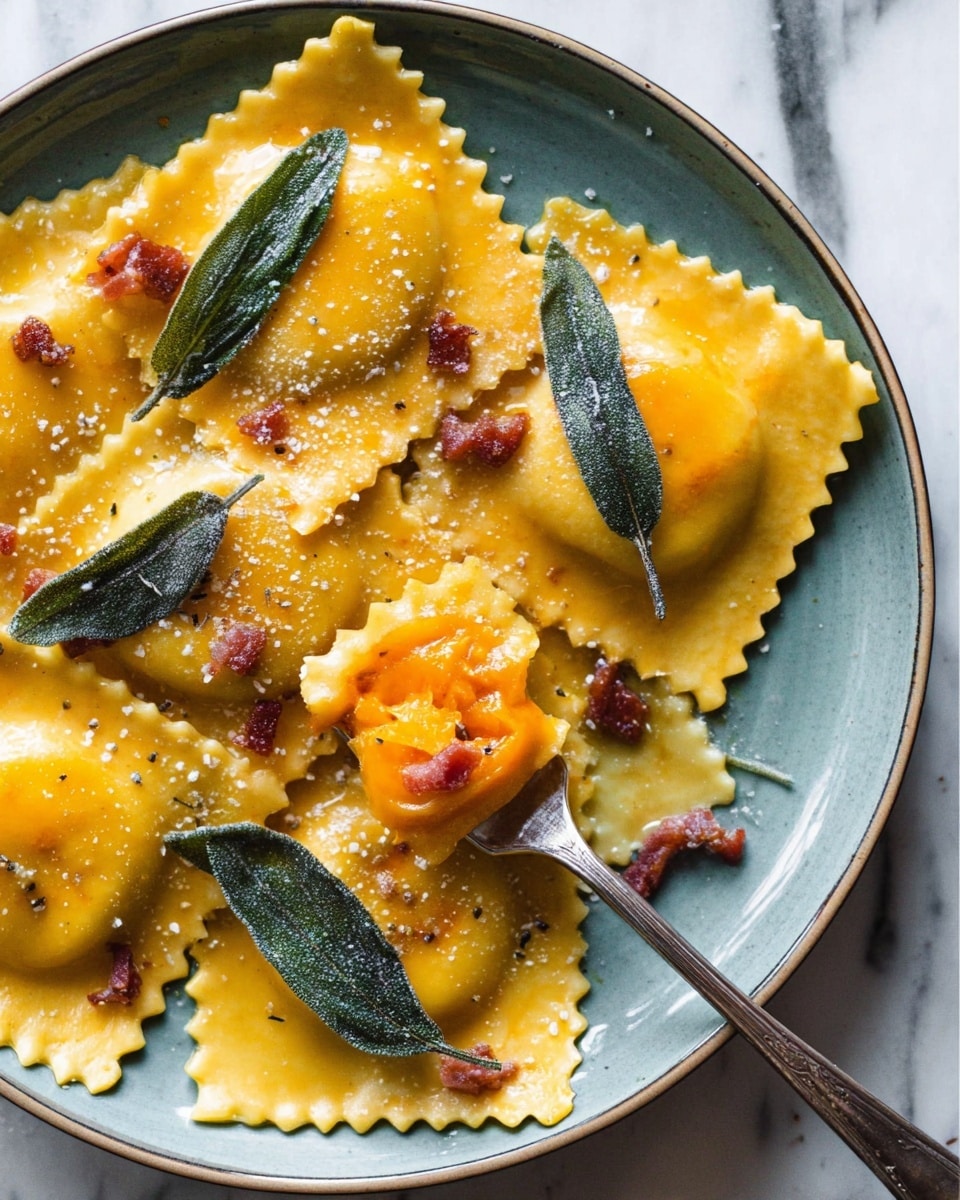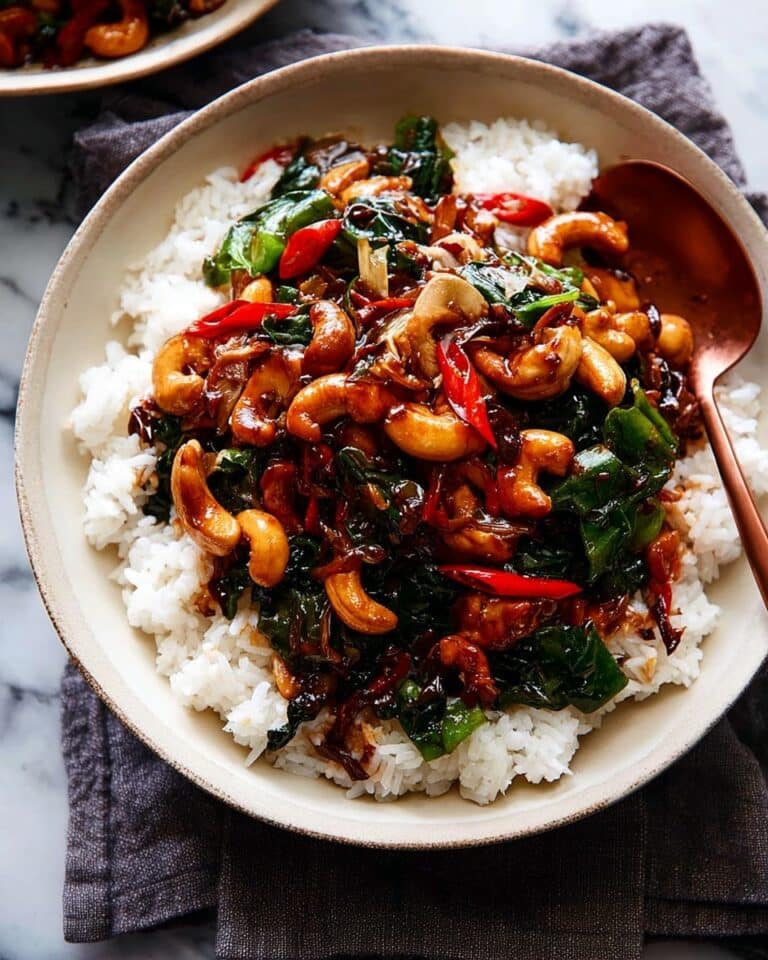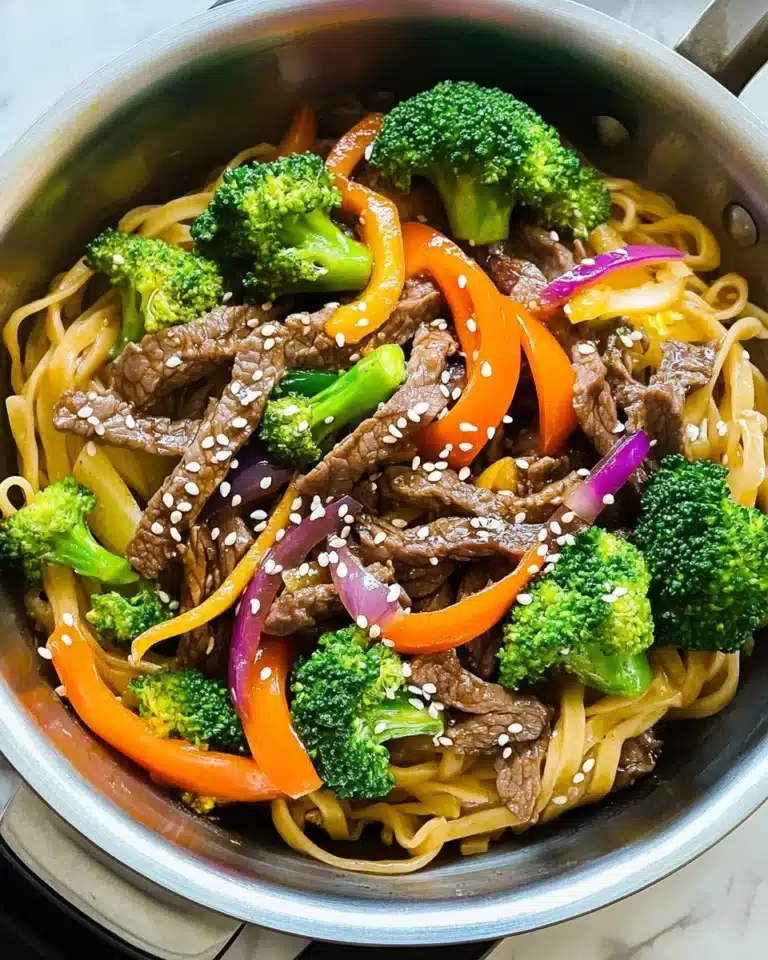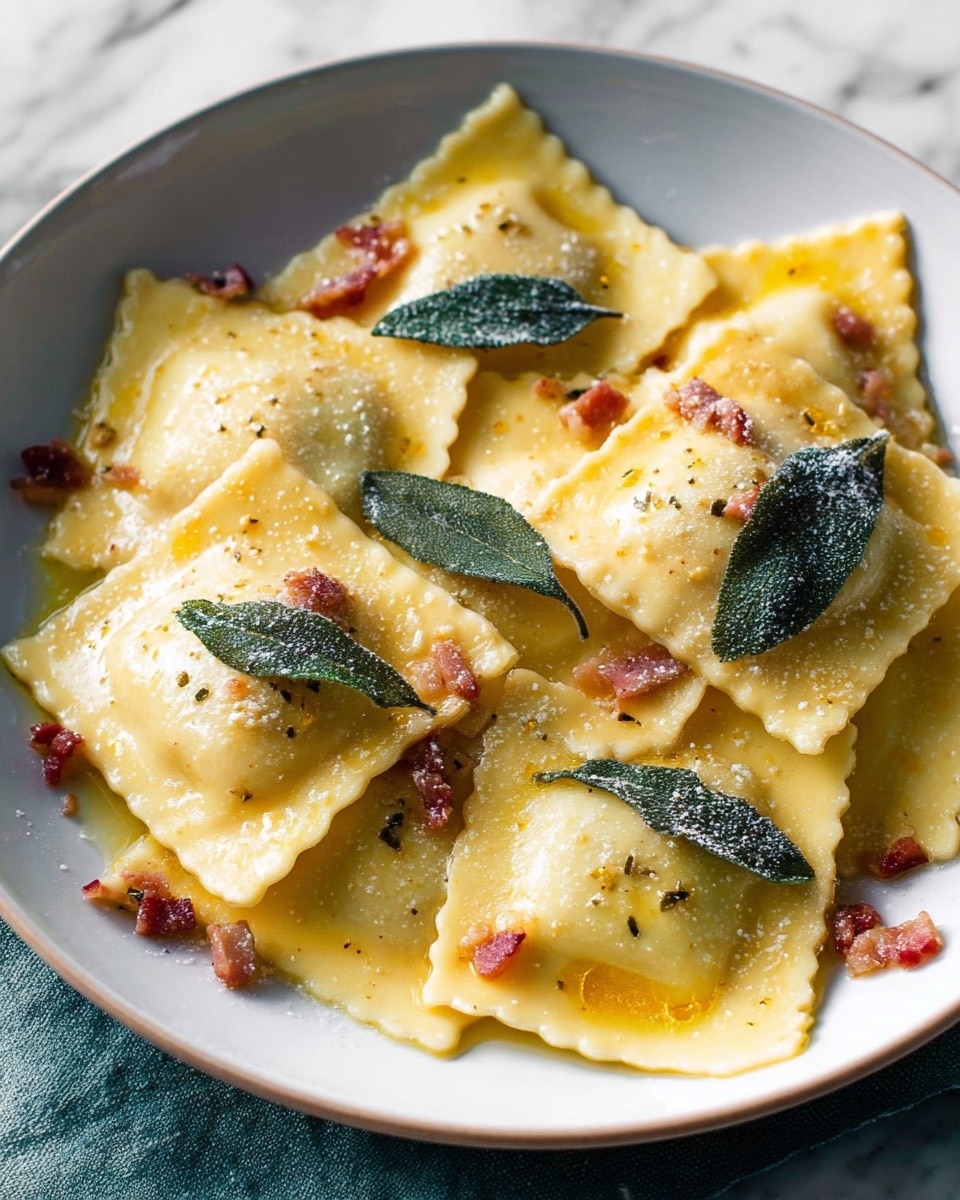
If you’re craving something special yet comforting, you absolutely must try this Fresh Homemade Butternut Squash Ravioli with Sage and Pancetta Recipe. It’s one of my all-time favorite dishes to make when fall rolls around—there’s something so magical about that silky butternut squash filling paired with crispy pancetta and fragrant sage. I remember the first time I made it from scratch; honestly, it felt like a proud kitchen victory. Once you make homemade pasta and fresh ravioli, you’ll get why it’s totally worth the little extra effort. Let me walk you through everything from the dough to plating, so you nail this gorgeous dish with ease.
Why You’ll Love This Recipe
- Incredible Freshness: From rolling your own pasta to the silky roasted butternut squash, everything tastes vibrant and homemade.
- Perfect Balance of Flavors: The buttery sage sauce and crispy pancetta add just the right touch of richness and savory crunch.
- Comfort Food with Elegance: This dish is fancy enough for guests but cozy enough for a family meal.
- Make-Ahead Friendly: You can prep the filling and even freeze ravioli ahead of time for busy nights.
Ingredients You’ll Need
Each ingredient plays its own role in making this recipe sing. I always recommend picking fresh sage leaves and high-quality pancetta—trust me, it makes a noticeable difference. The Tipo 00 flour is a game-changer for that silky pasta texture, but if you can’t find it, all-purpose flour will still work.
- Tipo 00 Flour: Finely milled for super smooth pasta dough that stretches beautifully.
- Eggs + Egg Yolk: They add richness and help bind the dough together perfectly.
- Olive Oil: Adds a little moisture and tenderness to the pasta.
- Semolina Flour: For dusting both your work surface and ravioli, it prevents sticking without drying out the dough.
- Whole Roasted Butternut Squash: The star of the filling—naturally sweet and creamy when pureed.
- Salted Butter: You’ll use it in both the filling and the finishing sauce for a luscious buttery layer.
- Nutmeg: Just a pinch adds cozy warmth to the squash filling.
- Fresh Sage Leaves: Their earthy flavor complements the sweetness of the squash perfectly.
- Pancetta Cubes: Crispy, salty, and irresistible—take your time to cook them right for texture.
- Parmesan Cheese: To sprinkle on top, adding a salty depth of flavor that ties everything together.
Variations
I love how versatile this Fresh Homemade Butternut Squash Ravioli with Sage and Pancetta Recipe is. You can personalize it easily to fit your mood, dietary needs, or what’s in your fridge.
- Vegetarian Version: Skip pancetta and use toasted pine nuts or crispy fried sage leaves to add that satisfying crunch.
- Cheesy Filling: Mix some ricotta or mascarpone into the butternut squash for an extra creamy texture—I’ve tried this and it’s a delicious twist!
- Herb Variations: Experiment with thyme or rosemary instead of sage for a slightly different flavor profile.
- Spice It Up: Add a pinch of cayenne or chili flakes to the filling for subtle warmth if you like a little heat.
How to Make Fresh Homemade Butternut Squash Ravioli with Sage and Pancetta Recipe
Step 1: Roast the Butternut Squash
Start by roasting the whole butternut squash—no peeling needed yet, just place it on a parchment-lined sheet pan and bake at 400°F for about an hour until a knife slides in easily. I learned early on that roasting the squash this way makes the flesh beautifully tender and naturally sweet, which is key for your filling. After it cools, peel and scoop out the seeds, then blend until silky smooth. You can chill or freeze this puree until you’re ready to assemble your ravioli.
Step 2: Make the Pasta Dough
If you have a stand mixer with a roller attachment, this step is way easier, but a hand-crank pasta machine works just as well. Combine the flour, eggs, egg yolk, and olive oil (if using) in your food processor briefly to bring it all together. Then, knead it on a floured surface for a minute or two, cover it with an upturned bowl, and let it rest for about an hour. I like letting it rest longer—it really helps the dough relax so rolling it out becomes a breeze.
Step 3: Prepare the Butternut Squash Filling
Heat your chilled butternut squash puree in a small pot with butter and a generous pinch of nutmeg, stirring often so it doesn’t stick. Taste for salt—you may find the filling needs just a touch more to balance all that subtle sweetness. Then cool it completely in the fridge. Hot filling will make your pasta dough soggy, which you definitely want to avoid!
Step 4: Roll Out Your Pasta Sheets
Divide your dough into four pieces. Flatten one piece and start rolling it through your pasta machine on the widest setting twice, then continue reducing the thickness gradually—typically until setting #5 on my KitchenAid attachment—dusting with semolina flour to keep it from sticking. The dough should be thin and just slightly translucent, about 1mm thick. Don’t stress if your edges look a bit uneven; you’ll trim them later. Lay the sheets between parchment paper on a floured sheet pan to keep everything clean and manageable.
Step 5: Assemble the Ravioli
On one pasta sheet, place rounded teaspoons of your chilled filling spaced carefully about two finger-widths apart. Gently lay a second sheet on top and carefully press around each mound to push out any air. This is such an important step to prevent bursting later, so go slow. Seal the edges firmly, then cut your ravioli squares using either a fluted cutter or a sharp knife, trimming them to about 2½ to 3 inches square. Transfer them to a parchment-lined pan dusted with semolina and cover to keep them fresh while you finish assembling.
Step 6: Cook Pancetta and Make Sage Butter Sauce
Fry pancetta cubes until slightly crisp and drain on paper towels so they keep their crunch. In the same pan, melt butter and slowly add your fresh sage leaves, letting the butter brown just slightly for that caramelized flavor. I usually pull the pan off the heat a little early because the residual warmth finishes the browning—this trick keeps the butter from burning and adds that perfect nutty aroma.
Step 7: Cook the Ravioli and Serve
Bring a large pot of generously salted water to a boil. Test cook a few ravioli first so you can gauge timing—usually 3 to 6 minutes depending on thickness. They’re ready when they float and taste tender but still hold their shape. Use a slotted spoon to transfer them delicately to plates, then spoon over the sage butter sauce and sprinkle with pancetta and freshly grated Parmesan. The contrast of textures and flavors here is absolutely divine.
Pro Tips for Making Fresh Homemade Butternut Squash Ravioli with Sage and Pancetta Recipe
- Rest the Dough Properly: Don’t rush the gluten rest—it’s what helps your dough roll out beautifully thin and easy to work with.
- Keep Filling Chilled: Always use cold filling when assembling ravioli to prevent sogginess and keep dough firm.
- Seal Ravioli Carefully: Use your fingers or a fork to press out all air bubbles, preventing leaks during boiling.
- Freeze Extras Individually: Lay out your ravioli on parchment in a single layer to freeze before transferring to a bag—this way they won’t stick together.
How to Serve Fresh Homemade Butternut Squash Ravioli with Sage and Pancetta Recipe
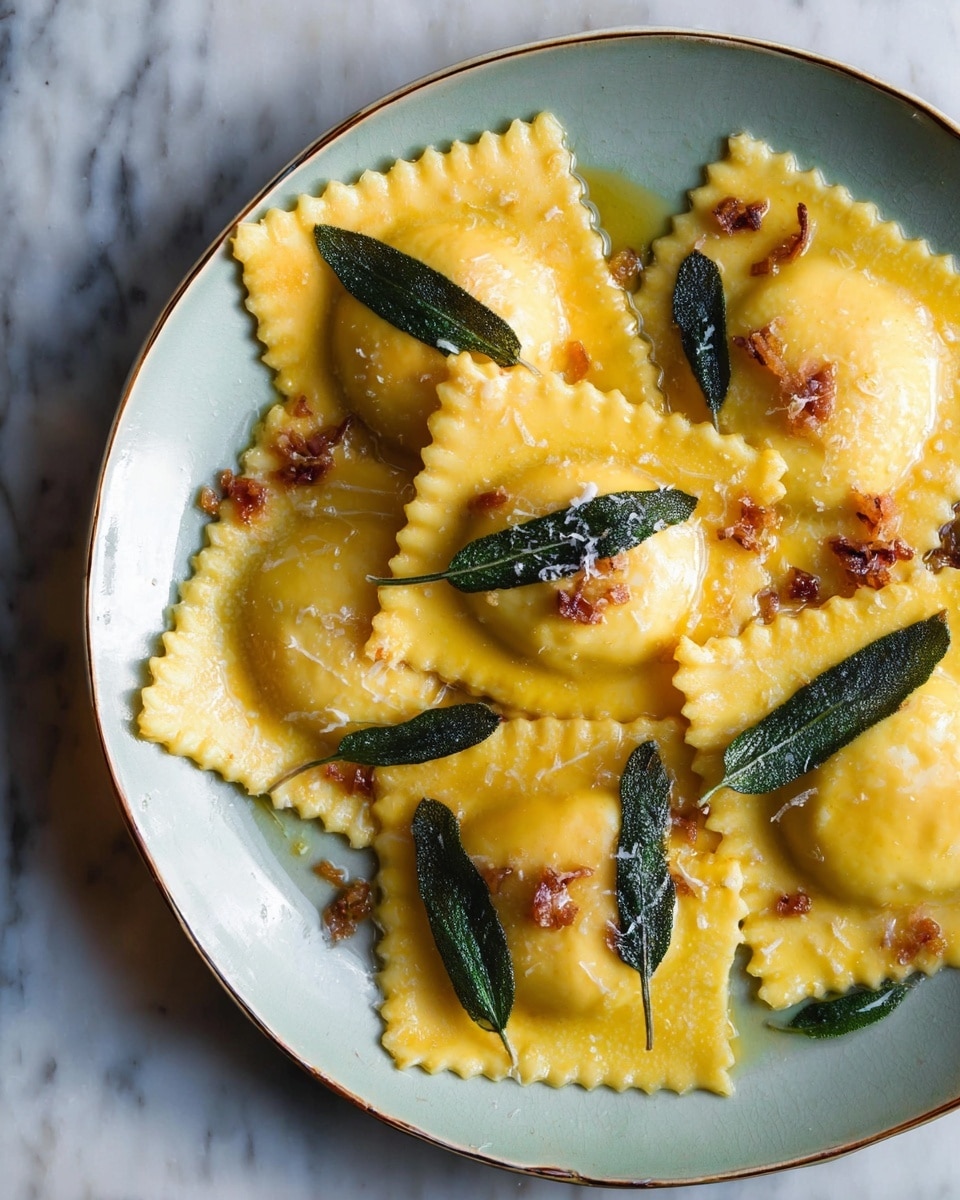
Garnishes
I always top my ravioli with extra crispy sage leaves and a generous handful of freshly grated Parmesan cheese. The sage leaves aren’t just a pretty garnish—they add the perfect aroma and a little crispy texture that contrasts beautifully with the soft pasta. A light drizzle of good-quality extra virgin olive oil on top at the end is another personal favorite touch.
Side Dishes
My family loves a simple side salad with peppery arugula and lemon vinaigrette to cut through the richness of the pasta. Roasted Brussels sprouts or garlic green beans work well, too. If you want to keep the vibe cozy, a crusty baguette for mopping up that sage butter sauce is essential.
Creative Ways to Present
For special occasions, I’ve arranged the ravioli in pretty circles on serving platters, topped with bits of pancetta and sage leaves sprinkled artfully. Serving individual portions on warm plates with a drizzle of brown butter and some microgreens gives an elegant, restaurant-style look. It’s a fun dish to impress guests, especially when paired with a crisp white wine.
Make Ahead and Storage
Storing Leftovers
I learned the best way to keep leftover cooked ravioli tender is to store them in an airtight container in the fridge, separated by parchment or plastic wrap so they don’t stick. They’re best eaten within 1-2 days for peak freshness. If you leave them longer, the pasta can become mushy.
Freezing
Freezing homemade ravioli works wonders. Lay them in a single layer on parchment paper, freeze until solid (about 1-2 hours), then transfer to a freezer bag. This method prevents sticking and keeps shape intact. I’ve frozen these ravioli for up to a month with no flavor loss, making it a handy shortcut for busy weeks.
Reheating
Reheat frozen ravioli directly in boiling salted water—just add an extra minute or two to cooking time. For leftovers from the fridge, a quick sauté in the sage butter sauce on medium heat refreshes their texture and flavor wonderfully. I avoid microwaving because it tends to dry out the pasta and filling.
FAQs
-
Can I use pre-made pasta sheets for this recipe?
Absolutely! If you’re short on time or new to making pasta dough, pre-made fresh pasta sheets are a great shortcut. Just make sure to dust them with semolina flour to keep the ravioli from sticking and follow the same assembly and cooking steps for the filling and sauce.
-
How do I prevent the ravioli from bursting while cooking?
The key is properly sealing each ravioli and removing all air pockets when assembling. Press the dough gently but firmly around the filling and edges. Also, avoid overcrowding the pot when boiling, and cook them gently at a simmer rather than a rolling boil.
-
What’s the best way to roast butternut squash for the filling?
Roasting the whole squash at 400°F until very tender is my favorite method because it intensifies the natural sweetness and makes peeling easier. You can also roast cubed squash tossed with a bit of oil and salt if you prefer, but whole roasting is hands-off and yields silky puree perfect for the filling.
-
Can I make the filling ahead of time?
Yes! Making the butternut squash filling a day or two ahead saves you time on assembly day. Keep it chilled in an airtight container and give it a good stir before using. You can even freeze it if you want to prep well in advance.
-
Is this recipe suitable for beginners?
Definitely! While homemade pasta takes a bit of practice, this recipe breaks down every step clearly. Start slow, especially with rolling the dough and sealing the ravioli, and you’ll be impressed by your first batch. Plus, I share plenty of tips above to help you avoid common pitfalls.
Final Thoughts
This Fresh Homemade Butternut Squash Ravioli with Sage and Pancetta Recipe holds a special place in my heart because it combines the joy of crafting something entirely from scratch with flavors that feel both comforting and refined. Making ravioli by hand reminds me to slow down, enjoy the process, and share delicious moments with loved ones. If you’re up for a bit of kitchen fun and reward, give this recipe a go—you’ll love that tender pasta, the sweet squash, and that irresistible buttery, crispy finish as much as my family does.
Print
Fresh Homemade Butternut Squash Ravioli with Sage and Pancetta Recipe
- Prep Time: 1 hour 30 minutes
- Cook Time: 5 minutes
- Total Time: 1 hour 35 minutes
- Yield: 4 servings
- Category: Main Course
- Method: Boiling
- Cuisine: Italian
- Diet: Halal
Description
This Fresh Homemade Butternut Squash Ravioli recipe features tender pasta envelopes filled with a sweet and savory roasted butternut squash mixture, paired with a nutty butter and sage sauce accented by crispy pancetta. From roasting the squash to rolling the dough by hand or with a pasta machine, this delicate ravioli is perfect for an elegant yet comforting meal.
Ingredients
For the Pasta Dough
- 300 g Tipo 00 Flour
- 3 large eggs
- 1 large egg yolk
- Olive oil (optional, small drizzle)
- Semolina flour, for dusting
For the Butternut Squash Filling
- 1 whole butternut squash, whole-roasted (to yield 400 g / about 1 3/4 cups roasted squash)
- 42 g (3 tbsp) salted butter
- Generous pinch of nutmeg
- Salt, to taste
For the Butter and Sage Sauce
- 115 g (8 tbsp) salted butter
- 8 fresh sage leaves
- 113 g (4 oz) cubed pancetta (such as Citterio “cubetti”)
- Parmesan cheese, for serving
Instructions
- Roast the Butternut Squash: Place a whole unpeeled butternut squash on a parchment-lined sheet pan and roast at 400°F (200°C) for about 1 hour or until a sharp knife easily pierces through. Cool for about 20 minutes, then peel, scoop out seeds, and process the flesh in a blender or food processor until smooth. Chill or freeze until ready to use.
- Make the Pasta Dough: In a food processor fitted with a metal blade, add the flour, eggs, and olive oil (if using). Process for 15-20 seconds until dough forms. Remove to a work surface, cover with an inverted bowl, and let rest for 5 minutes. Knead the dough into a smooth ball for 1-2 minutes, cover again, and allow to rest for 30 minutes to 1 hour to relax gluten.
- Prepare the Butternut Squash Filling: In a small pot, heat the roasted butternut squash, 42 g butter, and nutmeg over low heat, stirring occasionally to prevent sticking. Season with salt to taste. Transfer to a bowl and chill for at least 1 hour to prevent soggy ravioli.
- Set Up Workstation for Ravioli Assembly: Clear a large, clutter-free surface. Dust surface and pasta roller with semolina flour to prevent sticking. Line two sheet pans with parchment paper and cut additional parchment to layer between pasta sheets.
- Roll Pasta Dough into Sheets: Divide dough into 4 equal pieces. Flatten one piece into a roughly 5×8-inch disc. Roll through the widest pasta machine setting (#1) twice, then successively through settings 2 to 5 twice each, dusting with semolina flour as needed to prevent sticking. The dough should be about 1 mm thick and translucent. Trim edges, cut sheets into 10-12 inch lengths, and cover sheets with parchment. Repeat for remaining dough pieces.
- Assemble and Cut Ravioli: Place dollops of chilled butternut squash filling (rounded teaspoons) spaced two finger widths apart along the center of a pasta sheet. Lay a second sheet on top. Press gently around each mound to seal out air bubbles and seal edges. Cut into strips, then into 2.5 to 3-inch squares using a fluted ravioli cutter or knife. Transfer assembled ravioli onto semolina-dusted parchment-lined sheet pans. Cover with a towel or inverted sheet pan.
- Cook Pancetta and Prepare Sauce: Cook the pancetta in a pan until slightly crisp. Drain on paper towels. In the same pan, melt 115 g butter with sage leaves, allowing the butter to brown slightly but not burn, then remove from heat to control timing.
- Cook the Ravioli: Bring a large pot of salted water to a boil. Test cook 1-2 ravioli first for 3-6 minutes or until tender, depending on dough thickness. Cook remaining ravioli in batches, gently stirring occasionally. Remove cooked ravioli with a slotted spoon and transfer to a serving dish.
- Serve: Spoon brown butter and sage sauce over the ravioli. Garnish with crispy sage leaves and pancetta. Serve topped with freshly grated Parmesan cheese.
Notes
- This recipe produces light, tender homemade ravioli filled with sweet butternut squash, perfectly complemented by a nutty brown butter and sage sauce.
- You can roast the butternut squash several days in advance and chill or freeze the puree until ready to use.
- For best results, chill the filling before assembling to avoid soggy dough.
- If not cooking immediately, freeze assembled ravioli on parchment-lined pans, then transfer to bags for later use.
- Use semolina flour for dusting both your work surface and pasta sheets to prevent sticking during rolling and assembly.
- Cooking times vary depending on pasta thickness—always do a test cook.
Nutrition
- Serving Size: 1 serving (approximately 6 ravioli)
- Calories: 520 kcal
- Sugar: 4 g
- Sodium: 520 mg
- Fat: 30 g
- Saturated Fat: 14 g
- Unsaturated Fat: 14 g
- Trans Fat: 0 g
- Carbohydrates: 45 g
- Fiber: 4 g
- Protein: 15 g
- Cholesterol: 160 mg

